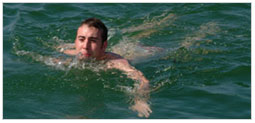Modified: August 5, 2016 9:32am
Latest News

PRESS RELEASE
From the Office of the Commissioner of Health, Dr. Gale R. Burstein
Date August 5, 2016
CONTACT: Mary C. St. Mary/Mary.StMary@Erie.Gov
Phone: 716.858.4941/ Mobile: 716.253.3925
Fresh Water Swimming Safety Tips
Don’t Drink the Water!
ERIE COUNTY, NY—In this hot and dry summer, the idea of a cooling dip into the pool, lake, river or pond sounds appealing. Water-based physical activity, such as swimming, improves physical and mental health throughout life; however, it can put people at risk for recreational water–associated illness and injury.
Did you know?
- Americans swim hundreds of millions of times each year in pools, oceans, lakes, rivers and hot tubs/spas.
- Swimming is the most popular recreational activity for children & teens (ages 7-17).
- Most people have a safe and healthy time enjoying the water, but illnesses and injuries can occur.

When selecting a location to go swimming--in the interest of public health--swimming at permitted facilities offers advantages:
• Permitted pools offer disinfected water which protects against disease causing agents.
• Permitted beaches are natural bodies of water that are evaluated for possible contamination.
• The bathing permitted facilities are regulated to maintain safe and sanitary bathing conditions.
• Look for posted hours of operation at permitted facilities to plan a swimming outing.
• When facilities are posted as closed, a public health risk may exist at that location at that time and another permitted swimming location should be selected.
- Do not swim in areas with warnings against swimming.
"We know people are venturing into local waterways to cool off this summer, so we advise them to be careful and exercise precautions," stated Dr. Gale Burstein, Erie County Commissioner of Health (“ECDOH”). "We certainly do not mean to discourage people from enjoying water activities, but we want residents to understand the potential risks involved. ECDOH works with other state and local partners to monitor and test beach water to inform residents of the water quality and we hope residents will heed posted beach advisories when they see them."
Illnesses associated with poor water quality include sore throat, stomach cramps, vomiting and diarrhea. Children, the elderly or people with weakened immune systems have a greater risk of becoming ill when swimming in waters that harbor natural and man-made contaminants. Microorganisms can enter the body through the mouth, nose and ears, as well as through cuts and wounds. Therefore, swallowing the water or immersing one's head or wounds increases the risk of illness. Some microorganisms occur naturally, while others come from human and animal waste. These enter the water from sewage overflows, polluted storm water runoff, sewage treatment plant malfunctions, urban and rural runoff after it rains, boating wastes, malfunctioning individual sewage treatment systems and agricultural runoff.
"Most people can swim and enjoy the water without any problems or concerns," added Burstein. "But, contaminants can find their way into all waterways, so there is always a slight level of risk for infections, especially for those who have chronic illnesses."
Waterways used for recreational purposes are never risk-free, but there are several precautions people can take to reduce their risk of illness including:
- Do not swim near a drainage pipe or in a ditch, or near runoff or littered areas.
- Do not swim in areas with warnings against swimming.
- Avoid swimming after heavy rains.
- Avoid ingesting or swallowing the water.
- Minimize immersing your head when swimming.
- Avoid swimming with an open cut, wound or skin infection.
- Shower after swimming.
Swim Safely
ECDOH also reminds adults that they can protect themselves and children and reduce the risk of drowning by taking the following precautions:
- Always have adult supervision when people are in or around the water. This is especially important for children and people who have seizure disorders or other medical conditions that could cause them to lose consciousness.
- Never swim alone. Always swim with a buddy.
- Take swimming lessons.
- Learn CPR.
- Do not use air-filled or foam toys in place of life jackets.
- Use alcohol responsibly around water and avoid its use entirely when supervising children.
- Teach children to never run, push or jump on others around water.
- Keep a phone near the pool or other water body, along with rescue equipment, such as a life preserver and a shepherd's hook -- a long pole with a hook at the end swimmers can grab to be pulled out of the water if in distress.
- Ensure that pools are surrounded by a fence at least four feet high. Pool gates should self-close and self-latch at a height small children cannot reach.
Never dive into water until there is 100 percent certainty that it is deep enough. Shallow water, underwater logs, big rocks or other debris are all dangerous when diving into the rivers, lakes or swimming holes..
# # #
For More Information:
Centers for Disease Control and Protection (“CDC”) – Healthy Swimming
CDC – Healthy Swimming Brochure
New York State Department of Health

